VISITING YOSEMITE IN MARCH
Learn what to expect when visiting Yosemite National Park in March
Updated: 08/10/2022
Winter is a magical time in Yosemite National Park. There is nothing like watching snow blanket the granite domes and giant sequoias. Visiting the park in March has terrific benefits as well as some drawbacks. If you can make it to Yosemite in March, you will have a fantastic trip and leave with an appreciation for the snow and solitude of winter in the park.
benefits of visiting in march
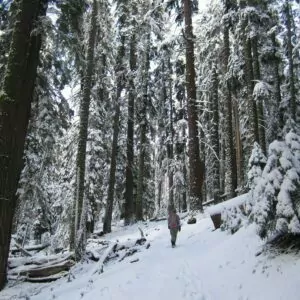 The biggest benefit to visiting Yosemite in March is the lack of crowds. Summer is the busiest time of the year, and spring and fall are also bustling—although not nearly as busy as summer. Winter is a season of peace and quiet. The other main benefit to visiting in March is the beauty of the snow covering the domes of the Valley or the giant sequoias of Mariposa Grove. The low winter lighting makes Yosemite a photographer’s dream. It is truly a winter wonderland.
The biggest benefit to visiting Yosemite in March is the lack of crowds. Summer is the busiest time of the year, and spring and fall are also bustling—although not nearly as busy as summer. Winter is a season of peace and quiet. The other main benefit to visiting in March is the beauty of the snow covering the domes of the Valley or the giant sequoias of Mariposa Grove. The low winter lighting makes Yosemite a photographer’s dream. It is truly a winter wonderland.
Another pro of visiting in March is the ease of booking accommodations. Trying to plan a trip to Yosemite in the summer any less than six months in advance will leave you wondering if there are even any accommodations available, never mind any that are affordable. But in winter, reservations are usually more open, so if the kids have an early spring break or if you have a couple of extra days off work, Yosemite in March is a great destination to squeeze in that last opportunity of the season for winter snow play while much of the rest of the country awake for spring.
While road closures around the park due to snow in the winter can be annoying, they are a mixed blessing as they force visitors to immerse themselves in the areas that are accessible indeed. Many summer visitors spend as much or more time driving from one destination to another as they enjoy the majestic scenery. But winter visitors get to avoid the rat race of seeing everything there is to see before leaving because so much of it is inaccessible. Instead, they are able to enjoy the places they can get to and not worry about missing out on this or that destination.
March is also a great time to view wildlife in Yosemite. While the black bears and reptiles will be hibernating, the rest of the park’s residents are far from dormant, and winter provides opportunities to see some creatures a summer visitor would never dream of. As an added bonus, the so annoying bugs in the summer cannot survive the cold and snow, so visitors are free from their itchy bites.
drawbacks of visiting in march
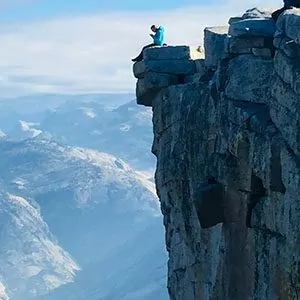 The snow in Yosemite is a double-edged sword, making it beautiful and closing many roads. The biggest drawback to visiting in March is the closures of Tioga Road and Glacier Point Road, typically closing in November and opening in late May. Highway 140, which runs through the Valley, is open year-round but may have snow chain restrictions depending on the amount of snow received. Mariposa Grove Road is also closed until at least March 15th, although you can park your car at the Mariposa Grove Welcome Plaza and walk the two-mile Washburn Trail to the grove.
The snow in Yosemite is a double-edged sword, making it beautiful and closing many roads. The biggest drawback to visiting in March is the closures of Tioga Road and Glacier Point Road, typically closing in November and opening in late May. Highway 140, which runs through the Valley, is open year-round but may have snow chain restrictions depending on the amount of snow received. Mariposa Grove Road is also closed until at least March 15th, although you can park your car at the Mariposa Grove Welcome Plaza and walk the two-mile Washburn Trail to the grove.
Despite many other destinations waking from wintery sleep in March to welcome the spring flowers, it is still very much winter in Yosemite and very cold. Be prepared to spend some extra time and possibly extra money packing and preparing the winter gear you will need to enjoy a trip to this park in the colder months. Visitors that do not prepare or do not come with the proper winter gear will most likely be cold and miserable, hardly having the winter wonderland experience they expected.
In addition, while there are still many opportunities to see wildlife, the iconic Yosemite black bears will be hibernating to wait out the cold. While the bears do occasionally venture out from their dens in the late winter, it is unlikely that many guests will see one. So if a black bear is on your bucket list, you might want to wait until late spring or summer for your visit.
things to do in march
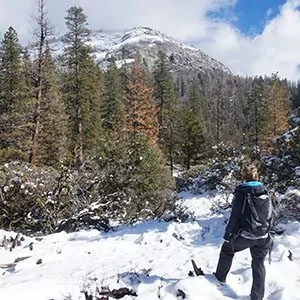 March is a great time to explore Yosemite without the crowds. The beauty and majesty of snow in the Valley make the park very photography-friendly. Ensure you catch sunrise or sunset from Tunnel View, just outside the Valley. Also, there are great hiking options in the Valley, Hetch Hetchy, Wawona, and Mariposa Grove. Visiting the Ansel Adams Gallery or the Yosemite Museum, both by the Yosemite Valley Visitor Center, are great options if the weather prevents you from spending time outside.
March is a great time to explore Yosemite without the crowds. The beauty and majesty of snow in the Valley make the park very photography-friendly. Ensure you catch sunrise or sunset from Tunnel View, just outside the Valley. Also, there are great hiking options in the Valley, Hetch Hetchy, Wawona, and Mariposa Grove. Visiting the Ansel Adams Gallery or the Yosemite Museum, both by the Yosemite Valley Visitor Center, are great options if the weather prevents you from spending time outside.
A unique experience in Yosemite in March is cross-country skiing, downhill skiing, snowboarding, or snowshoeing at Yosemite Ski and Snowboard Area. These are great ways to see areas of the park that are closed to cars, such as Mariposa Grove and Glacier Point Road. Yosemite Ski and Snowboard Area opens for the season on December 20th and closes on March 31st. Guided bus tours operate in the Valley year-round and are a great way to see the beautiful winter Valley from inside a warm bus. If the more adventurous snow sports aren’t your thing, the whole family will enjoy ample opportunities for sledding, snow-men-building, and other playing-in-the-snow activities. Both Crane Flat and Yosemite Hospitality host areas for such snow play, and there’s an outdoor ice skating rink at Curry Village, which you won’t want to miss.
While there are some options for hiking and backpacking in Yosemite in March, your options are limited due to snow. However, some short hiking options are available, and guided, all-inclusive hikes will allow you to relax and enjoy the area as someone else does all the planning and figuring out details about which hike is safe or which is open. Many visitors also enjoy stargazing on cold winter nights. Wrap up in your warmest layers and probably a blanket too, but you won’t want to miss the brilliant constellations of winter.
Another great activity in March is landscape and wildlife photography. The stunning vistas that have been the subject of thousands– if not millions– of pictures present some unique photo opportunities wrapped in their shawls of snow. You don’t need a fancy camera or much photography skills to capture these amazing scenes. Local wildlife is a popular photography subject. Those who patiently wait by the river or hike into the backcountry will likely see animals such as mink, otters, waterfowl, eagles, and perhaps even a bobcat, many of which are seldom observed in the summer.
Things to see in March
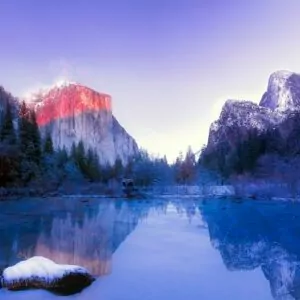 Between all the things to do in Yosemite in March, make sure you don’t miss these sights to see. Here is a short– non-exhaustive– list of some things that you will definitely want to put on your itinerary for a visit to this park in March.
Between all the things to do in Yosemite in March, make sure you don’t miss these sights to see. Here is a short– non-exhaustive– list of some things that you will definitely want to put on your itinerary for a visit to this park in March.
Tunnel Overlook: Perhaps the most famous of the overlooks on the road into the valley, it’s hard not to stop at this fantastic vista no matter how many times you’ve been there with El Capitan on your left, Bridalveil Falls on your right, Half Dome poking into the sky in the distance, and the Merced river threading through the pines in the valley. While this view is spectacular any time of year, the scene takes on a new air of wildness when every rock and tree is dusted with snow.
Mariposa Grove: While you can’t drive to this grove of fantastically huge sequoias in the winter, it is well worth the short hike to see these massive trees dusted with snow. Rent some snowshoes or take a guided snowshoe tour to this must-see Yosemite attraction.
Yosemite Valley Chapel: Nestled snugly among the pines, this functioning church is the oldest standing building in Yosemite and is well worth a stop. Though it is usually not noticed by the stream of cars passing by it, the chapel is arguably more picturesque in the winter with its red sides, single spire, and a shawl of snow wrapped around it.
Granite Monoliths: Half Dome and El Capitan, two of the most famous cliffs in the world, are a must-see– or maybe a can’t-miss– on a trip to Yosemite in March, and they are definitely part of what makes this park so unique. During the summer, these massive rocks stand out among the green and brown shades of earth and trees, but during the winter, the white accents of snow give them an entirely different air of wilderness and remoteness.
Wildlife: While some wildlife, such as bears and reptiles are hibernating in the colder months, there are still plenty of resident animals to see in February, including otters, minks, owls, coyotes, bobcats, fishers, snowshoe hares, red foxes, even mountain lions.
Glacier Point Road: This road is a must-see for all seasons, but in winter, it is closed to cars and only accessible by snowshoe or ski. If you’re up for an adventure, this trek is well worth it as it allows you to get out of the village and into the wilderness, where you’ll have a better chance of seeing wildlife and a guarantee of seeing remarkable sweeping vistas.

hiking in march
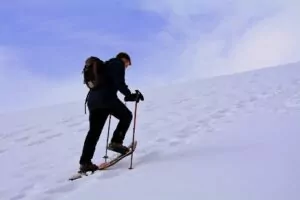 While many trails are closed for the winter, plenty are still accessible. Many of the lower trails in the Valley, such as Bridalveil Fall, Mirror Lake, Lower Yosemite Falls, and the Vernal Falls footbridge on the Mist Trail, stay open through the winter. But trails that take you higher in elevation, like Upper Yosemite Falls and the 4-mile Trail, are closed. The cables for Half Dome will be taken off at the end of October. However, Hetch Hetchy and Wawona remain open all year despite being snow-covered. You can read NPS’ current conditions before heading out for the day.
While many trails are closed for the winter, plenty are still accessible. Many of the lower trails in the Valley, such as Bridalveil Fall, Mirror Lake, Lower Yosemite Falls, and the Vernal Falls footbridge on the Mist Trail, stay open through the winter. But trails that take you higher in elevation, like Upper Yosemite Falls and the 4-mile Trail, are closed. The cables for Half Dome will be taken off at the end of October. However, Hetch Hetchy and Wawona remain open all year despite being snow-covered. You can read NPS’ current conditions before heading out for the day.
Snowshoeing is a great winter alternative to hiking as it allows hikers to stay on top of the snow instead of sinking into it. Yosemite has many excellent snowshoeing trails for both beginners and experienced snowshoers. Glacier Point Road is open to snowshoeing (as well as cross-country skiing), where you can enjoy views of the valley and the Badger Pass area. Dewey Point Meadow Trailhead is another option that branches off of Glacier Point Road.
In addition to general snow play, the Crane Flats area also offers snowshoeing options such as the Clark Range View Trail, which is about 4 miles round trip along the Merced River and is nice for beginner snowshoers. If you’ve snowshoed before and want a challenge, the Tuolumne Grove Trail will take you through a remarkable Sequoia grove. Coming in around 2.5 miles, it is a bit of a climb and definitely a harder trek than Clark Range View Trails despite being shorter. There is also a great option toward the southern end of the park in Mariposa Grove, which boasts massive sequoias that you won’t want to miss
Early mornings will be chilly in March, so be prepared with hats, gloves, and warm layers. It will get warmer throughout the day, so bring a daypack where you can put your layers as you take them off. Even though it is cold out, ensure you still drink plenty of water throughout the day. Plan on starting your hike around 7 or 8, and make sure you can finish it within 6-8 hours due to the shorter days of winter. If you plan on doing extensive hiking or snowshoeing, you might want to consider bringing microspikes, crampons, and/or trekking poles to give you more traction on your boots and help you keep your balance. It’s very highly discouraged to hike on snow-covered trails without snowshoes because of the dangers of post-holing and how much this can rip up the nicely packed snow for other hikers. Because so many of the trials are obscured by snow, visitors should bring a GPS as well as a map and compass to navigate by. Even if it is not actively snowing, you should not rely on your footprints to find your way back to the trailhead.
Backpacking IN march
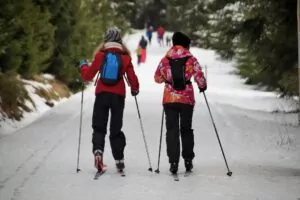 Traditional backpacking in Yosemite in March is nearly impossible due to all the snow and ice. While the famous backpacking trails, such as the John Muir Trail that begins in Happy Isles in Yosemite Valley, are still there, they are so obscured by snow that they are impassable. But if you’re really determined to try out your winter gear, break out the four-season tent and your -10 degree sleeping bag because you can still camp in Yosemite in the winter. The campgrounds that remain open in the winter are not the backcountry, but you can still base camp here backpacking style to try out your gear.
Traditional backpacking in Yosemite in March is nearly impossible due to all the snow and ice. While the famous backpacking trails, such as the John Muir Trail that begins in Happy Isles in Yosemite Valley, are still there, they are so obscured by snow that they are impassable. But if you’re really determined to try out your winter gear, break out the four-season tent and your -10 degree sleeping bag because you can still camp in Yosemite in the winter. The campgrounds that remain open in the winter are not the backcountry, but you can still base camp here backpacking style to try out your gear.
Another alternative is to leave your hiking boots and trekking poles in the car and rent some cross-country skis and ski poles and trek to one of the two ski huts that are only open during the winter, one at Glacier Point and one at Ostrander Lake. With their rustic feel, these stone and brick buildings will encourage you to spend the night, along with the fact that the round trip ski to the hut at Glacier Point is 21 miles, a feat that only advanced skiers should attempt. Remember that Reservations and/or wilderness permits are required for overnight stays. There are also a few other marked trails for cross-country skiing in the Mariposa Grove and Crane Flats areas, but anywhere beyond this, backpackers should expect to be hiking in avalanche areas.
weather in march
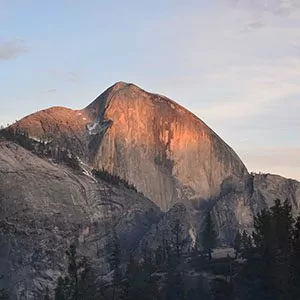 Yosemite is a massive park with locations boasting elevations of 4,00 to 10,000 ft. Obviously, the weather varies depending on what elevation you are at, but generally, in winter, the locations with higher elevation, such as Tuolumne, are closed to all but advanced skiers. The winter in Yosemite Valley is typically cold and snowy or rainy, although sunny and warm days are not too uncommon. The average temperature in Yosemite Valley and Wawona in March is a high of 58 and a low of 34 degrees Fahrenheit (14/1 degrees Celsius). On average, it snows and/or rains nine days in March. As winter begins to subside, especially toward the end of March, the days get longer, and more snow melts every day. This starts to bring the water level back up to nearly springtime flow rates. However, this means that ice forms overnight as the temperatures continue to dip below freezing. This can cause icy road conditions, chains may still be required, and microspikes and crampons are recommended for boots. The mornings and evenings will be brisk and chilly, so best to plan your afternoon activities if you can finish them before the evening.
Yosemite is a massive park with locations boasting elevations of 4,00 to 10,000 ft. Obviously, the weather varies depending on what elevation you are at, but generally, in winter, the locations with higher elevation, such as Tuolumne, are closed to all but advanced skiers. The winter in Yosemite Valley is typically cold and snowy or rainy, although sunny and warm days are not too uncommon. The average temperature in Yosemite Valley and Wawona in March is a high of 58 and a low of 34 degrees Fahrenheit (14/1 degrees Celsius). On average, it snows and/or rains nine days in March. As winter begins to subside, especially toward the end of March, the days get longer, and more snow melts every day. This starts to bring the water level back up to nearly springtime flow rates. However, this means that ice forms overnight as the temperatures continue to dip below freezing. This can cause icy road conditions, chains may still be required, and microspikes and crampons are recommended for boots. The mornings and evenings will be brisk and chilly, so best to plan your afternoon activities if you can finish them before the evening.
The town of Oakhurst, which sits on the doorstep of Yosemite on the southwest side, has lows in the 40s and highs in the 60s in March with less snow than the valley, while the northeastern gateway, Lee Vining, which will only be used by skiers in the winter, has lows in the low 20s and highs in the 50s.
The weather in March in Yosemite can be unpredictable and change quickly. Even though the season is moving toward spring, there can still be snowstorms, sleet, and rain. It is best to prepare for the worst weather you might encounter, even if it ends up that most of your days visiting the park are sunny and on the warmer side. Make sure to bring rain as well as snow gear and that your warm layers will retain their heat even if they get wet from rain and/or snow. Layering clothes is the best way to prepare for a trip like this and know when to throw in the towel and return to the shelter if the weather moves in.
While natural wildfires are less likely to occur in the winter months, the National Parks Service does occasionally run controlled burns for the health of the forest. While this can be frustrating because of smoke and haze in some areas, it should not harm air quality.
wildlife in march
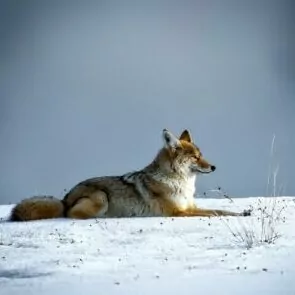 Despite the cold, the resident wildlife of Yosemite is still active in March, and the snow and lessened crowds can give you an excellent opportunity to see some amazing creatures. Most of the bears will still be in hibernation, but some might venture out if there are grasses and shrubs to eat. However, visitors have a better chance of seeing some of the park’s more elusive creatures in winter than a summer visitor would. This is largely due to certain animals’ behavior in the winter, the lack of crowds, and the fact that snow leaves creatures’ footprints crisp and clear for people to see. The Merced River is a great place to start searching for wildlife, and if you’re patient, you might see otters, minks, waterfowl, and eagles coming to the river to feed and drink. Both coyotes and mule deer are common to see in the summer, but the deer have shed their antlers for the winter, and you might be able to catch a glimpse of a coyote hunting moles with their signature nose-diving into the snow.
Despite the cold, the resident wildlife of Yosemite is still active in March, and the snow and lessened crowds can give you an excellent opportunity to see some amazing creatures. Most of the bears will still be in hibernation, but some might venture out if there are grasses and shrubs to eat. However, visitors have a better chance of seeing some of the park’s more elusive creatures in winter than a summer visitor would. This is largely due to certain animals’ behavior in the winter, the lack of crowds, and the fact that snow leaves creatures’ footprints crisp and clear for people to see. The Merced River is a great place to start searching for wildlife, and if you’re patient, you might see otters, minks, waterfowl, and eagles coming to the river to feed and drink. Both coyotes and mule deer are common to see in the summer, but the deer have shed their antlers for the winter, and you might be able to catch a glimpse of a coyote hunting moles with their signature nose-diving into the snow.
Visitors who are really diehard for seeing some of the more unusual wildlife can take a trek into the backcountry on snowshoes and look for more elusive animals, such as a great gray owl perched in a bough or a pure white snowshoe hare bounding across the trail. Red foxes, fishers, bobcats, and even mountain lions live in the higher forest, and while seeing one is not out of the question, visitors are more likely to see their footprints in the snow. There is even still rumored to be a wolverine or two that still lives in the Sierra Nevada Mountains.
You might be happy that some of the animals– such as mosquitos and other biting bugs as well as poisonous snakes– are in hibernation or can’t live in the cold and thus are not a worry for visitors. While you may have to be more patient to find wildlife in Yosemite in March than you do in the summer, they are all well worth the wait.
Recommended Wildland trips in March
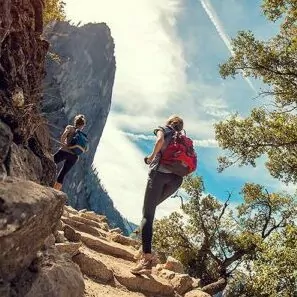 Visiting Yosemite in March is exciting, but it can also be overwhelming to plan with so many logistics that you have to deal with regarding the snow, weather, and activities. But you can bypass all the headaches of planning a trip in March by booking one of our tours with an expert Wildland Trekking guide. With an array of tours to pick from that range from overnight camping trips to shorter day hikes, we’ve picked just a few that we especially recommend for the month of March.
Visiting Yosemite in March is exciting, but it can also be overwhelming to plan with so many logistics that you have to deal with regarding the snow, weather, and activities. But you can bypass all the headaches of planning a trip in March by booking one of our tours with an expert Wildland Trekking guide. With an array of tours to pick from that range from overnight camping trips to shorter day hikes, we’ve picked just a few that we especially recommend for the month of March.
Yosemite Valley Basecamp Tour: With a comfortable base camp for the evenings and wonderful hiking adventures during the day, this guided base camp tour takes all the hassle out of a visit to Yosemite in March and lets you truly enjoy the season. With tents, sleeping bags, sleeping pads, day packs, trekking poles, and all meals included, this trip is a must for those looking for a base camp hiking adventure.
Private Vernal and Nevada Falls: This hike can be intimidating to do on your own with the amount of snow left in March, but with an expert hiking guide, it becomes a picturesque journey. Trek up to these two gorgeous waterfalls and stop for included snacks and a picnic lunch along the way. This is one of the most popular hikes in the park, but there won’t be a crowd in March, and you can have peace of mind while our expert guides lead you along the way.
Best of Yosemite Inn-Based Tour: Few things are better than sinking into a warm bed after hiking in the snow after a long, exciting day. On this 5-day, inn-based tour, you’ll get to do just that at your cozy accommodations after hiking some of the most spectacular treks in the entire park. Visit waterfalls, high peaks, stunning overlooks, and giant sequoias, all the while not having to worry about any logistics of your trip. All-inclusive with meals, accommodations, local transportation, trekking poles, and a day pack included, you won’t want to miss this exciting Yosemite adventure.
JOIN A GUIDED HIKING ADVENTURE
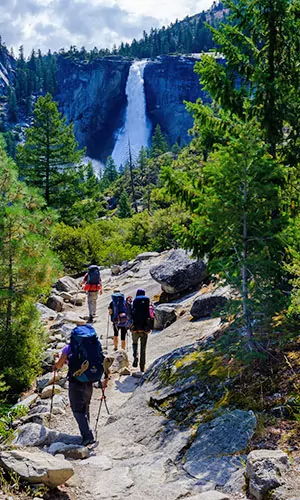 Yosemite National Park is home to some of the world’s most epic and amazing hiking vacations. Wildland Trekking offers trips with the best of Yosemite: waterfalls, views, wildlife, solitude, adventure, and fascinating natural and cultural interpretation.
Yosemite National Park is home to some of the world’s most epic and amazing hiking vacations. Wildland Trekking offers trips with the best of Yosemite: waterfalls, views, wildlife, solitude, adventure, and fascinating natural and cultural interpretation.
Guided Yosemite treks are all-inclusive, which covers permits; local transportation (excluded on specific tours); meals; equipment; safety systems, and professional hiking/wilderness guides; all of which allow visitors to maximize their time in Yosemite and focus entirely on enjoying the Park.
YOSEMITE ADVENTURE TOURS
GUIDED BACKPACKING ADVENTURES: these are for people interested in an authentic Yosemite hiking adventure away from the roads and crowds.
PORTERED TRIPS: on these innovative trips, guests hike with light day packs and camp near stunning backcountry locations.
INN-BASED PACKAGES: these tours are all-inclusive packages with lodging, amazing daily hikes, expert guides, meals, transportation, and more!
CAMPING-BASED HIKING PACKAGES: camping-based hiking packages provide all-around hiking experiences of Yosemite on wonderful outdoor vacations.
DAY HIKE TOURS: maximize your day in Yosemite on a fully guided, award-winning hiking tour on one of the Park’s best trails.





